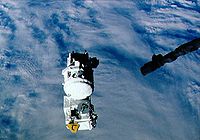
STS-39
Encyclopedia
Mission parameters
- MassMassMass can be defined as a quantitive measure of the resistance an object has to change in its velocity.In physics, mass commonly refers to any of the following three properties of matter, which have been shown experimentally to be equivalent:...
:- Orbiter landing with payload: 95846 kilograms (211,304.3 lb)
- Payload: 5663 kilograms (12,484.8 lb)
- PerigeePerigeePerigee is the point at which an object makes its closest approach to the Earth.. Often the term is used in a broader sense to define the point in an orbit where the orbiting body is closest to the body it orbits. The opposite is the apogee, the farthest or highest point.The Greek prefix "peri"...
: 248 kilometres (154.1 mi) - Apogee: 263 kilometres (163.4 mi)
- InclinationInclinationInclination in general is the angle between a reference plane and another plane or axis of direction.-Orbits:The inclination is one of the six orbital parameters describing the shape and orientation of a celestial orbit...
: 57.0° - PeriodOrbital periodThe orbital period is the time taken for a given object to make one complete orbit about another object.When mentioned without further qualification in astronomy this refers to the sidereal period of an astronomical object, which is calculated with respect to the stars.There are several kinds of...
: 89.6 min
Mission highlights
Launch was originally scheduled for 9 March, but during processing work at Pad A, significant cracks were found on all four lug hinges on the two external tank umbilical door drive mechanisms. NASA managers opted to roll back the vehicle to the VAB on 7 March, and then to OPF for repair. The faulty hinges were replaced with units taken from orbiter ColumbiaSpace Shuttle Columbia
Space Shuttle Columbia was the first spaceworthy Space Shuttle in NASA's orbital fleet. First launched on the STS-1 mission, the first of the Space Shuttle program, it completed 27 missions before being destroyed during re-entry on February 1, 2003 near the end of its 28th, STS-107. All seven crew...
, and reinforced. Discovery was returned to the launching pad on 1 April, and the launch was rescheduled for 23 April. The mission was again postponed when, during prelaunch external tank loading, a transducer on high-pressure oxidizer turbopump for main engine number three showed readings out of specification. The transducer and its cable harness were replaced and tested. The launch was rescheduled for 28 April. Actual launch occurred at 28 April 1991, 7:33:14 am EDT. Launch weight: 112207 kilograms (247,374.1 lb).
STS-39 was a dedicated Department of Defense mission. Unclassified payload included Air Force Program-675
AFP-675
AFP-675 was a Space Shuttle experiment package that was carried into orbit on Discovery as part of STS-39.AFP-675 consisted of six experiment packages mounted on a pallet in the Discovery's cargo bay. The total weight of the package was 5,080 kilograms...
(AFP675); Infrared Background Signature Survey (IBSS) with Critical Ionization Velocity
Critical ionization velocity
Critical ionization velocity is the relative velocity between a neutral gas and plasma , at which the neutral gas will start to ionize...
(CIV), Chemical Release Observation (CRO) and Shuttle Pallet Satellite-II (SPAS-II) experiments; and Space Test Payload-1 (STP-1). Classified payload consisted of Multi-Purpose Release Canister (MPEC). Also on board was Radiation Monitoring Equipment III (RME III) and Cloud Logic to Optimize Use of Defense Systems-IA (CLOUDS-I).
STS-39 was the first unclassified Department of Defense (DoD)-dedicated Space Shuttle mission. There had previously been seven Shuttle missions dedicated to the DoD, but those were considered classified and information about the operation or success of the payloads or experiments was not released. For STS-39, only the payload in the Multi-Purpose Experiment Canister (MPEC) was listed as classified.



and firings of the orbiter's engines, in wavelengths ranging from infrared to far ultraviolet. As part of the sophisticated experiments, five spacecraft or satellites were deployed from the
payload bay, and one was retrieved later during the mission.
Carried in the orbiter's cargo bay were: Air Force Program-675 (AFP-675); Infrared Background Signature Survey (IBSS); Space Test Program-01 (STP-01); and the MPEC. Inside the crew cabin were the Cloud Logic to Optimize the Use of Defense Systems-1A (CLOUDS 1-A) experiment and the Radiation Monitoring Equipment-III (RME-III).
The Remote Manipulator System arm in the payload bay was used to deploy the Shuttle Pallet Satellite-II (SPAS-II) on which
the IBSS was mounted. Among other observations, the SPAS-II/IBSS watched Discovery as it performed some orbital maneuvers including the "Malarkey Milkshake.". The deployment of IBSS was delayed a day, until Flight Day Four, to give priority to the completion of the CIRRIS (Cryogenic Infrared Radiance Instrumentation for Shuttle) experiment which was depleting its liquid helium coolant supply faster than expected while making observations of auroral and airglow emissions.
As usual, crew members faced some unexpected challenges during the mission. After working only about four hours, two tape
recorders could not be reactivated. The tape recorders were designed to record observations made by three instruments on
AFP-675. In a complicated two-hour bypass repair operation, the astronauts had to route wires and attach a splice wire to a
Ku-band antenna system so the data could be sent directly to a ground station.
The high orbital inclination of the mission, 57 degrees with respect to the equator, allowed the crew to fly over most of
Earth's large land masses and observe and record environmental resources and problem areas.
STS-39 landed on 6 May 1991, 2:55:35 pm EDT, at Runway 15, Kennedy Space Center
Kennedy Space Center
The John F. Kennedy Space Center is the NASA installation that has been the launch site for every United States human space flight since 1968. Although such flights are currently on hiatus, KSC continues to manage and operate unmanned rocket launch facilities for America's civilian space program...
, FL. Landing was diverted there because of unacceptably high winds at the planned landing site, Edwards. Landing weight: 95940 kilograms (211,511.5 lb). Rollout distance: 9,235 ft, rollout time: 56 s.
See also
- Space scienceSpace scienceThe term space science may mean:* The study of issues specifically related to space travel and space exploration, including space medicine.* Science performed in outer space ....
- Space shuttleSpace ShuttleThe Space Shuttle was a manned orbital rocket and spacecraft system operated by NASA on 135 missions from 1981 to 2011. The system combined rocket launch, orbital spacecraft, and re-entry spaceplane with modular add-ons...
- List of space shuttle missions
- List of human spaceflights chronologically

